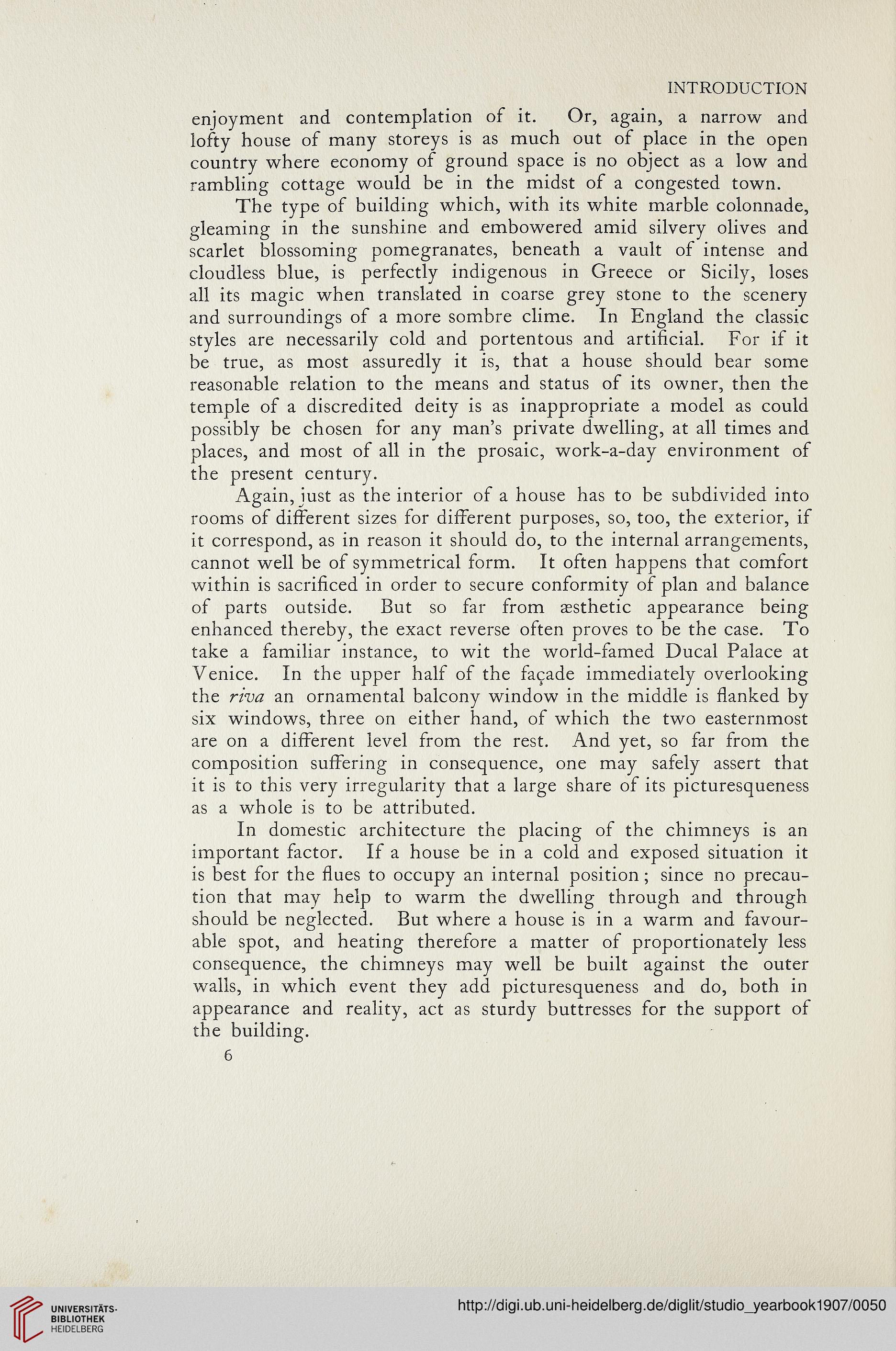INTRODUCTION
enjoyment and contemplation of it. Or, again, a narrow and
lofty house of many storeys is as much out of place in the open
country where economy of ground space is no object as a low and
rambling cottage would be in the midst of a congested town.
The type of building which, with its white marble colonnade,
gleaming in the sunshine and embowered amid silvery olives and
scarlet blossoming pomegranates, beneath a vault of intense and
cloudless blue, is perfectly indigenous in Greece or Sicily, loses
all its magic when translated in coarse grey stone to the scenery
and surroundings of a more sombre clime. In England the classic
styles are necessarily cold and portentous and artificial. For if it
be true, as most assuredly it is, that a house should bear some
reasonable relation to the means and status of its owner, then the
temple of a discredited deity is as inappropriate a model as could
possibly be chosen for any man’s private dwelling, at all times and
places, and most of all in the prosaic, work-a-day environment of
the present century.
Again, just as the interior of a house has to be subdivided into
rooms of different sizes for different purposes, so, too, the exterior, if
it correspond, as in reason it should do, to the internal arrangements,
cannot well be of symmetrical form. It often happens that comfort
within is sacrificed in order to secure conformity of plan and balance
of parts outside. But so far from aesthetic appearance being
enhanced thereby, the exact reverse often proves to be the case. To
take a familiar instance, to wit the world-famed Ducal Palace at
Venice. In the upper half of the facade immediately overlooking
the riva an ornamental balcony window in the middle is flanked by
six windows, three on either hand, of which the two easternmost
are on a different level from the rest. And yet, so far from the
composition suffering in consequence, one may safely assert that
it is to this very irregularity that a large share of its picturesqueness
as a whole is to be attributed.
In domestic architecture the placing of the chimneys is an
important factor. If a house be in a cold and exposed situation it
is best for the flues to occupy an internal position; since no precau-
tion that may help to warm the dwelling through and through
should be neglected. But where a house is in a warm and favour-
able spot, and heating therefore a matter of proportionately less
consequence, the chimneys may well be built against the outer
walls, in which event they add picturesqueness and do, both in
appearance and reality, act as sturdy buttresses for the support of
the building.
6
enjoyment and contemplation of it. Or, again, a narrow and
lofty house of many storeys is as much out of place in the open
country where economy of ground space is no object as a low and
rambling cottage would be in the midst of a congested town.
The type of building which, with its white marble colonnade,
gleaming in the sunshine and embowered amid silvery olives and
scarlet blossoming pomegranates, beneath a vault of intense and
cloudless blue, is perfectly indigenous in Greece or Sicily, loses
all its magic when translated in coarse grey stone to the scenery
and surroundings of a more sombre clime. In England the classic
styles are necessarily cold and portentous and artificial. For if it
be true, as most assuredly it is, that a house should bear some
reasonable relation to the means and status of its owner, then the
temple of a discredited deity is as inappropriate a model as could
possibly be chosen for any man’s private dwelling, at all times and
places, and most of all in the prosaic, work-a-day environment of
the present century.
Again, just as the interior of a house has to be subdivided into
rooms of different sizes for different purposes, so, too, the exterior, if
it correspond, as in reason it should do, to the internal arrangements,
cannot well be of symmetrical form. It often happens that comfort
within is sacrificed in order to secure conformity of plan and balance
of parts outside. But so far from aesthetic appearance being
enhanced thereby, the exact reverse often proves to be the case. To
take a familiar instance, to wit the world-famed Ducal Palace at
Venice. In the upper half of the facade immediately overlooking
the riva an ornamental balcony window in the middle is flanked by
six windows, three on either hand, of which the two easternmost
are on a different level from the rest. And yet, so far from the
composition suffering in consequence, one may safely assert that
it is to this very irregularity that a large share of its picturesqueness
as a whole is to be attributed.
In domestic architecture the placing of the chimneys is an
important factor. If a house be in a cold and exposed situation it
is best for the flues to occupy an internal position; since no precau-
tion that may help to warm the dwelling through and through
should be neglected. But where a house is in a warm and favour-
able spot, and heating therefore a matter of proportionately less
consequence, the chimneys may well be built against the outer
walls, in which event they add picturesqueness and do, both in
appearance and reality, act as sturdy buttresses for the support of
the building.
6




